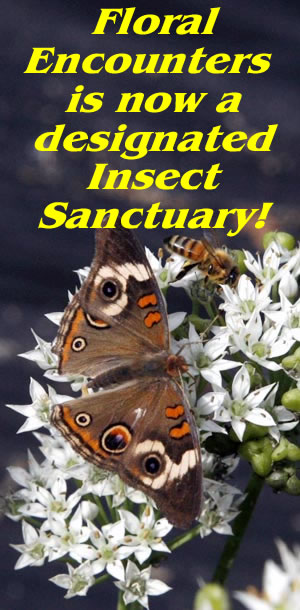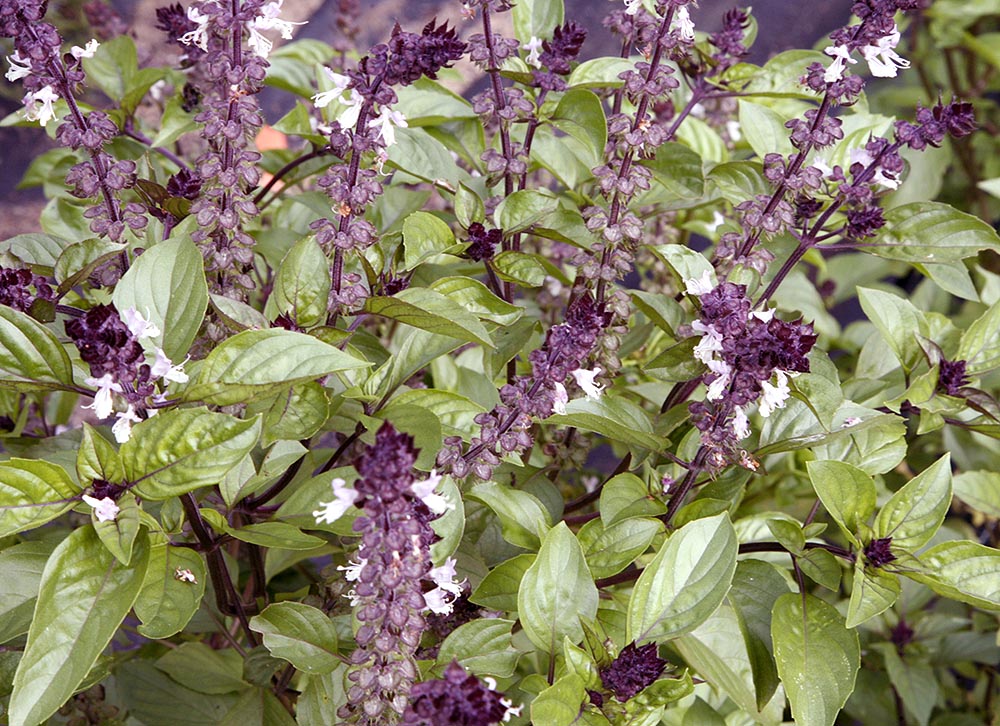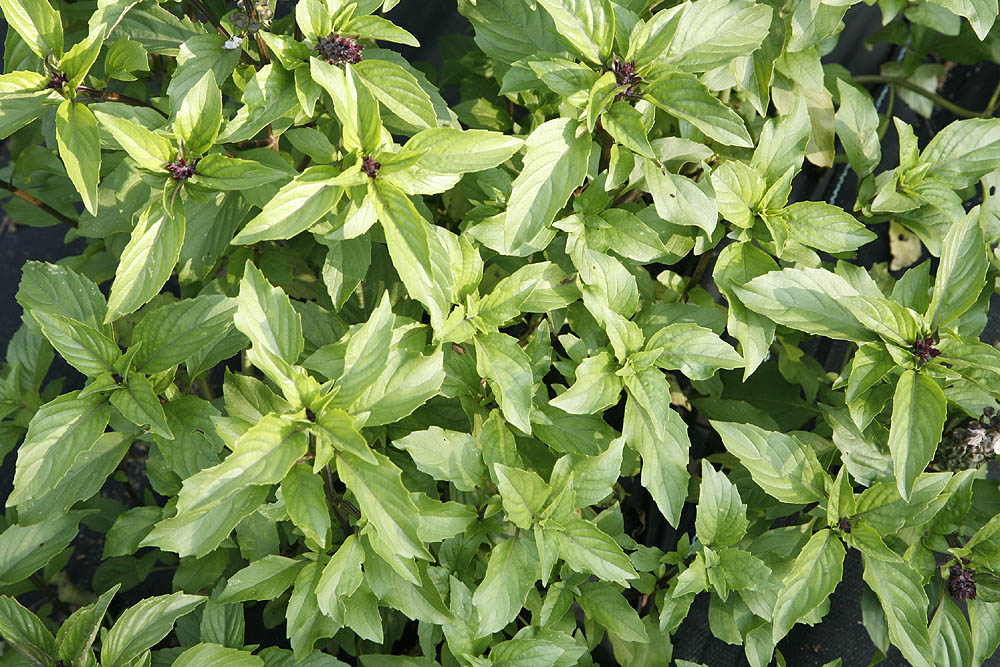Cinnamon Basil is a lovely annual plant, worth growing as an ornamental even if you don't want to harvest the cinnamon scented leaves. The purple stems and purple flower stalks make it a striking addition to any herb garden or flower border. While most basils are grown just for their leaves this one has lovely flowers and makes an attractive ornamental in its own right. Don't want to eat it, then grow it anyway it's a lovely plant and very easy to grow. The cinnamon scent is attractive to humans but disliked by most wildlife including deer and insects.
Description of (Ocimum basilicum Cinnamon).
Cinnamon Basil has dark green ovoid leaves with gently scalloped margins and
deep veins. The leaves are sometimes tinged with purple and up to two inches
long. The leaves are arranged in opposite pairs on square stems that have a
distinctive purple red color. Flower spikes arise from the tops of the branches
with purple racemes and lighter pink to lilac flowers often tinged with bronze
that are two lipped and ½ inch long. The plant can grow 24- 36 inches
high and up to 18 inches wide. The leaves have a strong cinnamon scent.
Growing Cinnamon Basil (Ocimum basilicum Cinnamon) from Seed.
Cinnamon basil plants are easy to grow but the seedlings are slow to develop
at first and can be delicate. Starting seed indoors and growing on in pots to
a reasonable size before planting out is recommended. Follow our general
growing instructions. Keep compost slightly dry at all times but do not
let it dry out entirely. Pot on when seedlings are large enough to handle and
plant out after hardening off. Plant out with a 12 inch spacing.
Cinnamon Basil can easily be grown indoors in pots all year around to ensure
fresh herb for the kitchen. Starting seeds in early spring ready for outdoor
planting will help increase the season length. Seeds can then either be sown
throughout the year in pots if desired or sown directly in the ground once all
danger of frost has passed.
Germination usually takes about 14-20 days depending on temperature.
Location and Care of Cinnamon Basil (Ocimum basilicum Cinnamon).
This basil like all basils prefers full sun. It is a cultivar from Mexico so
it is more tolerant of hot climates than other basils. However in hot climates
a little afternoon shade is preferable. It needs a well drained soil and to
be watered regularly, it does not like wet feet. It also likes a pretty rich
soil and grows best with a good mulching. The more organic material and fertilizer
it gets the richer the leaf growth is. Lush leaves are usually what is required
on a basil plant unless its grown as an ornamental. For leaf harvest lots of
fertilizer and nitrogen will increase leaf growth and reduce it the likelihood
of flowering. If cared for it will produce a multitude of leaves that can be
constantly picked for use in the kitchen.
Normally the advise is to pinch off the flowers before they form to allow for more leaf production, but I just can't write that! Cinnamon basil flowers are just too pretty the pink flowers and dark burgundy heads standing out against the green foliage. Grow several plants and allow some to flower, its worth it. Even though it is said that no basil produces a decent crop of leaves after flowering we have found that cinnamon basil provides a pretty good amount. Flowering continues for quite some time so it's a great plant to enjoy. Ours tend to last until the frost knocks them down.
Basil is a tender plant and will not tolerate frost. As soon as the weather turns cold the leaves begin to turn black. In areas where there is not frost the plants can live for two or more years. Basils can tolerate slightly acidic soils. If the pH is lower than 5.7, add a dressing of lime when preparing the soil.
If planting in a pot make sure that the roots have room to grow. These plants can get fairly large up to three feet in height and two wide so they need enough room to grow and produce good leaves. If the plants don't have enough room to root they will flower sooner and die.
Plant spacing and airflow.
Allow plenty of air space around your basil plants. IF growing a row keep plants
at least 2 feet apart. If growing in a border keep other plants back slightly
to allow for
airflow. Don't grow Cinnamon Basil in areas where there is little
airflow. Cinnamon Basil can be highly susceptible to fungal molds and allowing
good airflow around the plant can greatly reduce the likelihood of this happening
to your plants.
Keep chemicals away from your basil.
Don't grow any Basil in a area where it could be sprayed by chemicals, if you
use chemicals on your lawn ensure that your basil plants are not right next
to it. Try not to grow it near your property boundary where chemicals used by
your neighbor may land on your plants. Always wash the leaves well before eating.
Great of decks, boxes and hanging baskets.
Cinnamon Basil is a very versatile plant and can be grown in hanging baskets,
pots and even on the windowsill offering fresh basil throughout the winter months.
If leaves are harvested regularly the plants can be kept small. This plant is
rich in several important nutrients, most notably vitamin A, vitamin C. It also
contains high concentrations of carotenoids like beta carotene, and these substances
are converted to vitamin A within the body. It may be a good source of iron,
potassium, and magnesium depending on what it can extract from your soil.
You can also use basil in the garden as a companion plant to repel aphids, mites, and tomato hornworms.
Harvesting of of Cinnamon Basil (Ocimum basilicum Cinnamon).
Once your basil plants are growing well pinch off the central stem when they
are about twelve inches high. After this prune back each stem when it has more
then 8 leaves on it. Harvest the young fresh leaves as needed, the plant grows
back quickly as the more it is harvested and pinched the more likely it will
be to branch and produce more leaves. Always harvest the leaves from the tops
of the stems taking about one third of the stem only. Pinch or cut with snips
or scissors when harvesting, don't tear the leaves off as this can cause wounds
allowing infection to enter the plant. Also don't just pull off one large leaf
or you will get no new growth and the plant can become stunted. Continuous harvesting
of new leaves allows more growth for recutting. If done effectively each plant
should yield about half a cup of leaves every week throughout the season. (expect
less on plants grown on indoors in windows).
Leaves can be frozen in air tight bags for later use, if drying pick whole stems, tie together and hang up to dry. Leaves can also be packed in jars in olive oil or used to flavor vinegar's for winter use. Make sure you harvest all your leaves before the first frost is due.
Edible Uses of Cinnamon Basil (Ocimum basilicum Cinnamon).
Cinnamon basil is used primarily as a garnish, to add a savory taste to some
raw dishes, soups and as an alternative to regular cinnamon. Steeping the leaves
in water and sugar will create a syrup that can be used to flavor desserts and
wherever regular cinnamon would be used. The leaves are delicate and should
be used fresh if possible or frozen as described above. Dried leaf looses its
aroma quickly. The fresh leaves can be stored in the refrigerator for about
a week.








